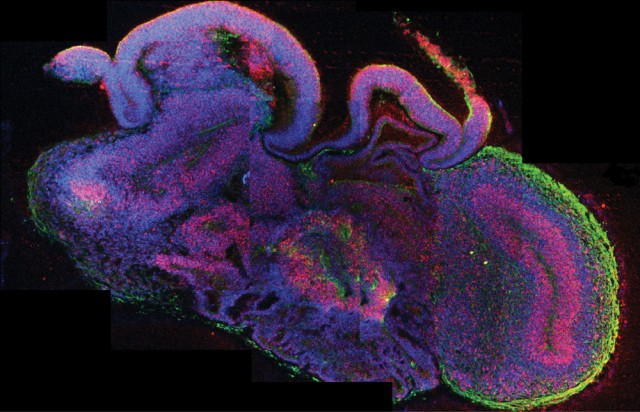First Lab-Grown Human ‘Mini Brains’
 |
Researchers create the first lab-grown human ‘mini brains’ |
A new three-dimensional culture system for growing mini brains in the lab is developed by Researchers in Austria. They began with a custom blend of human stem cells growing inside a spinning bioreactor, and coerced them to assemble into complex structures they call “cerebral organoids.” After two months of growth, these unassuming tenderloins reached their maximum size i.e. one far shy of an actual human brain — but they have persisted ten months now, and their survival appears indefinite.
In beginning, the researchers mixed together embryonic stem cells, ultimately derived from fetal tissue, and a smattering of cells known as induced pluripotent stem cells (iPS cells), which are extracted from more refined adult tissue. The agglomeration was encased in gel which acted as a mechanical scaffold to provide some structural integrity to the soft tissue. After transfer to the spinning bioreactor (pictured below), which facilitated nutrient delivery, a continuous sheet of tissue, known as neuroepithelia formed around a fluid cavity just as in the development of the ventricles of real brains. After a few weeks, specific brain regions like the cortex, and even a retina, began to form.
The researchers were able to tailor unique cerebral organoids that can be used to investigate particular human diseases. In one set of experiments they used iPS cells from the skin of a patient with a condition known as microcephaly (a condition where the brains fails to fully grow). The resulting organoids had much reduced proliferative capacity as a result of the cells adopting mature forms far too early on, reminiscent of the condition in actual development of the disease.
Growing whole organs in the lab is an essential tool to understand how they grow and differentiate, or specialize. The heart, for example, has a tough extracellular matrix which can be enzymatically extracted and used as a seed structure for stem cells to grow on.
A major limitation here, and with any cultured organ, is the lack of blood supply. The researchers attribute the lack of growth after two months to the inability of nutrients to diffuse to cells once a critical size is reached.
The vasculature also supplies a more subtle organizing influence in real tissues, namely pressure. By virtue of their elaborate connections, brains naturally have the most advanced nutrient supply system of any organ. In fact the very basis of their construction is that of directed flow and exchange of molecular currency across improbably vast distances under the direction of various pumps and meters. But without the pressurizing influence of the heart-primed vasculature, developing neural tissues are, in effect, unable to self-inflate beyond a certain limit.
In real embryos, a rapidly mineralizing skull threatens to dome up the works prematurely if the brain doesn’t supply sufficient counter force. Fortunately, the heart eventually gets its act together and comes online, together with oxygen bearing blood cells which begin to permeate the fluid now being pumped around the embryo.
If a blood supply, and corresponding capillary bed system, can eventually be sourced to developing organoids, perhaps these size constraints can be overcome. The full complexity of the adult brain far exceeds that of the structure of these primitive buttons of tissue.





Comments
Post a Comment